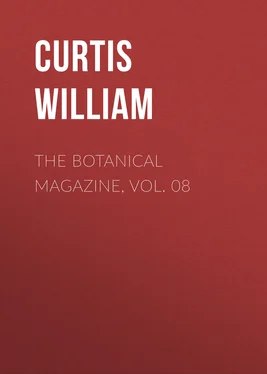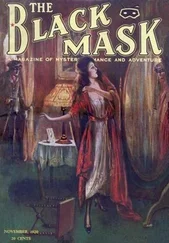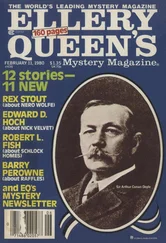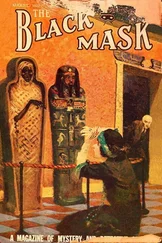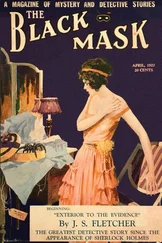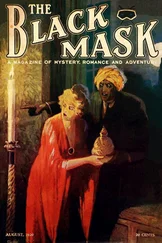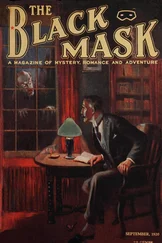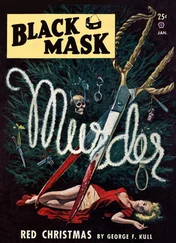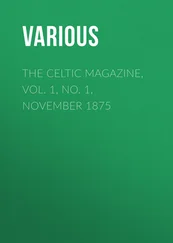Curtis William - The Botanical Magazine, Vol. 08
Здесь есть возможность читать онлайн «Curtis William - The Botanical Magazine, Vol. 08» — ознакомительный отрывок электронной книги совершенно бесплатно, а после прочтения отрывка купить полную версию. В некоторых случаях можно слушать аудио, скачать через торрент в формате fb2 и присутствует краткое содержание. Жанр: foreign_prose, Биология, foreign_edu, на английском языке. Описание произведения, (предисловие) а так же отзывы посетителей доступны на портале библиотеки ЛибКат.
- Название:The Botanical Magazine, Vol. 08
- Автор:
- Жанр:
- Год:неизвестен
- ISBN:нет данных
- Рейтинг книги:3 / 5. Голосов: 1
-
Избранное:Добавить в избранное
- Отзывы:
-
Ваша оценка:
- 60
- 1
- 2
- 3
- 4
- 5
The Botanical Magazine, Vol. 08: краткое содержание, описание и аннотация
Предлагаем к чтению аннотацию, описание, краткое содержание или предисловие (зависит от того, что написал сам автор книги «The Botanical Magazine, Vol. 08»). Если вы не нашли необходимую информацию о книге — напишите в комментариях, мы постараемся отыскать её.
The Botanical Magazine, Vol. 08 — читать онлайн ознакомительный отрывок
Ниже представлен текст книги, разбитый по страницам. Система сохранения места последней прочитанной страницы, позволяет с удобством читать онлайн бесплатно книгу «The Botanical Magazine, Vol. 08», без необходимости каждый раз заново искать на чём Вы остановились. Поставьте закладку, и сможете в любой момент перейти на страницу, на которой закончили чтение.
Интервал:
Закладка:
COROLLA four Petals of a pale red colour, forming in their mode of growth the upper half of a circle, the two uppermost linear, of a deeper colour near the apex, jointed below the middle, with a small green gland on each joint, standing on short round footstalks, which are hairy when magnified, the two side Petals nearly orbicular with long narrow claws, the part between the base of the Petal and the claw of a deeper red or crimson, fig. 2.
NECTARY situated below the Petals, perfectly white, somewhat ovate, the sides folding together, before the flower fully expands, nearly upright, embracing and containing within it the Pistillum and Stamen, on touching it ever so slightly with the point of a pin, while in this state, it suddenly springs back and quits the Pistillum, the lower elastic part of it is then bent in the form represented in a magnified view of the flower on the plate, fig. 4. this curious phœnomenon has not been noticed by Cavanille.
STAMEN: Filament one, tapering and very slender just below the Anthera, arising from the same part as (and placed opposite to the base of) the Nectary the lower part of it broader, somewhat fleshy, cartilaginous, and of the same nature as the inferior part of the Nectary, with a groove as that has on the inside, so that before the flower expands, the bases of each are like two half tubes, the sides of which, nearly touching each other, wholly enclose the Pistillum; as the fructification goes forward, the Filament, endowed also with an elastic power, bends back soon after the flower is open, betwixt the two uppermost Petals, and becomes invisible to an inattentive observer; the Anthera, which is large, is at first yellow, and afterwards dark brown, fig. 5.
PISTILLUM: Germen below the Calyx, round, smooth, and green; Style filiform, white, length of the Filament; Stigma forming a small villous head, fig. 6. in some of the flowers the Pistillum appears imperfect, being much shorter than usual, and wanting the Stigma, perhaps such have not acquired their full growth, fig. 6.
PERICARPIUM (from Cavanille) a round Capsule , of four cells, and four valves, the cells many-seeded.
SEEDS very minute, ovate, affixed to a four-cornered receptacle.
[255]
Cytisus Sessilifolius. Sessile-Leav'd, or Common Cytisus
Cal. 2-labiatus: 2/3 Legumen basi attenuatum.
CYTISUS sessilifolius racemis erectis, calycibus bractæa triplici, foliis floralibus sessilibus. Linn. Syst. Vegetab. ed. 14. Murr. p. 666. Ait. Kew. v. 2. p. 50.
CYTISUS glabris foliis subrotundis, pediculis brevissimis. Bauh. Pin. p. 390.
CYTISUS vulgatior, the common Tree Trefoile. Park. Parad. p. 440.
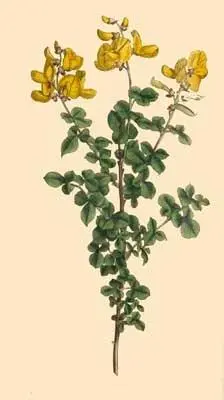
N o255.
The term sessilifolius has been given to this species of Cytisus, because the leaves are for the most part sessile, that is sit close to the branches, without any or very short footstalks; such they are at least on the flowering branches when the shrub is in blossom, but at the close of the summer they are no longer so, the leaves acquiring very evident footstalks.
It is a native of the more southern parts of Europe, and though in point of size and elegance it cannot vie with its kindred Laburnum, it is a deciduous shrub of considerable beauty, rarely exceeding the height of five or six feet, and producing a great profusion of bright yellow flowers, which continue in blossom a long while; they make their appearance in May and June, and are usually succeeded by seed-vessels which produce ripe seeds, by these the plant is readily propagated.
It is one of the most common shrubs we have, as well as one of the oldest inhabitants of our shrubberies, being mentioned by Parkinson in his Parad. Terrestris .
[256]
Ixia Longiflora. Long-Flower'd Ixia
Cor. 6-partita, campanulata, regularis. Stigmata 3.
IXIA longiflora foliis ensiformibus linearibus strictis, tubo filiformi longissimo. Ait. Kew. v. 4. p. 58.
GLADIOLUS longiflorus caule tereti, tubo longissimo, spathis foliisque linearibus glabris. Linn. Suppl. p. 96. Gmel. Syst. Vegetab. ed. 14. Murr. p. 86.
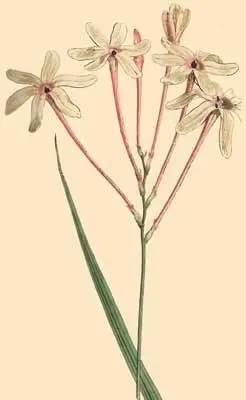
N o256.
We are not acquainted with a tribe of plants which stand more in need of elucidation than those of this genus; of the vast numbers imported from the Cape within these few years, where they are chiefly natives, and that for the most part by way of Holland, few comparatively are well ascertained; some of them appear subject to great variation, both in the size and colour of their blossoms (whether in their wild state they are thus inconstant, or whether there are seminal varieties raised by the persevering industry of the Dutch Florists, we have not yet had it in our power satisfactorily to ascertain); others like the present one have their characters strongly marked, and less variable; in general they are plants of easy culture, requiring chiefly to be protected from the effects of frost, the least degree of which is presently fatal to most of them.
The treatment recommended for the Ixia flexuosa is applicable to this and the other Cape species.
According to the Hort. Kew. this species was introduced by Mr. Masson in the year 1774.
It flowers from April to June.
[257]
Lychnis Chalcedonica. Scarlet Lychnis
Cal. 1-phyllus, oblongus, lævis. Petala 5-unguiculata. Limbo sub-bifido. Caps. 5-locularis.
LYCHNIS chalcedonica floribus fasciculatis fastigiatis. Linn. Syst. Vegetab. ed. 14. Murr. p. 435. Ait. Kew. v. 2. p. 16.
LYCHNIS hirsuta flore coccineo major. Bauh. Pin. 203.
FLOS Constantinopolitanus. Dod. Pempt. 178.
LYCHNIS chalcedonica flore simplici miniato. Single Nonsuch, or Flower of Bristow or Constantinople. Parkins. Parad. 253.
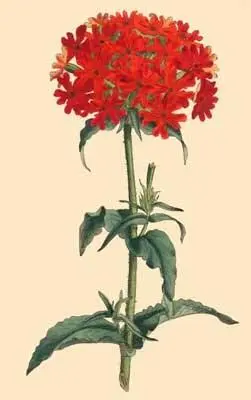
N o257.
The Scarlet Lychnis appears to have been a great favourite with Parkinson, he calls it a glorious flower, and in a wooden print of him prefixed to his Paradisus Terrestris , we see him represented with a flower of this sort in his hand of the double kind.
It grows spontaneously in most parts of Russia, and is one of our most hardy perennials.
The extreme brilliancy of its flowers renders it a plant, in its single state highly ornamental; when double, its beauty is heightened, and the duration of it increased.
It flowers in June and July.
The single sort may be increased by parting its roots in autumn, but more abundantly by seeds, which should be sown in the spring; the double sort may also be increased by dividing its roots, but more plentifully by cuttings of the stalk, put in in June, before the flowers make their appearance; in striking of these, however, there requires some nicety.
Читать дальшеИнтервал:
Закладка:
Похожие книги на «The Botanical Magazine, Vol. 08»
Представляем Вашему вниманию похожие книги на «The Botanical Magazine, Vol. 08» списком для выбора. Мы отобрали схожую по названию и смыслу литературу в надежде предоставить читателям больше вариантов отыскать новые, интересные, ещё непрочитанные произведения.
Обсуждение, отзывы о книге «The Botanical Magazine, Vol. 08» и просто собственные мнения читателей. Оставьте ваши комментарии, напишите, что Вы думаете о произведении, его смысле или главных героях. Укажите что конкретно понравилось, а что нет, и почему Вы так считаете.
